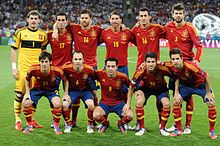UEFA Euro 2012 final
En route to the final, Spain finished top of Group C, with a draw against Italy and wins over Croatia and the Republic of Ireland.
Spain also became the first team to win three consecutive major tournaments (following Euro 2008 and the 2010 FIFA World Cup), all without conceding a single goal in the knockout stage.
[4][5] Qualifying rounds were held between August 2010 and November 2011, in which fifty-one teams were divided into nine groups of five or six, playing each other on a home-and-away round-robin tournament basis.
[15] Three minutes later, Spain equalised when midfielder David Silva assisted Cesc Fàbregas, who slotted the ball past goalkeeper Gianluigi Buffon.
Spain opened the goalscoring with defender Jordi Alba running to the touchline under pressure and sending a pinpoint cross to unmarked midfielder Xabi Alonso, who drove a powerful header past goalkeeper Hugo Lloris.
[19] Spain began to take control of the match with the introduction of Pedro and Fabregas, but failed to score over both halves, leading to a penalty shoot-out.
[19] Portugal looked to take the advantage, with midfielder João Moutinho as the next penalty taker, but his strike was kept out with a diving save from Casillas.
[19] The fourth Spanish penalty was taken by defender Sergio Ramos, who chipped the ball past Rui Patrício, in the style of former Czech footballer Antonín Panenka.
[20] Andrea Pirlo stepped up, and struck the free kick,[20] which went past Croatia goalkeeper Stipe Pletikosa, inside the left side of the goal.
Striker Antonio Cassano struck the first goal, from a Pirlo corner, which Republic of Ireland defender Damien Duff failed to clear.
[22] Near the end of the match, centre midfielder Keith Andrews was booked for the second time, after committing a foul on Pirlo, resulting in a sending off by Turkey referee Cüneyt Çakır.
[22] As the match headed its way into the 90 minutes, in injury time, Balotelli struck a volley past Given, assisted by attacking midfielder Alessandro Diamanti.
[23] England players also rounded off chances, through strikers Wayne Rooney and Danny Welbeck, midfielders Steven Gerrard and Scott Parker, and defenders Glen Johnson and Ashley Cole.
Italy dominated possession early, and after receiving the ball from Cassano, Balotelli opening the goalscoring in the 20th minute of the first half in the left corner inside the goal, heading past German goalkeeper Manuel Neuer.
[24] Sixteen minutes later Balotelli struck again, this time striking into the top right corner on a one-on-one with Neuer, assisted by a Montolivo lob over the German defence.
However, after the first two group games, coach Cesare Prandelli appeared to develop a distinct preference for a 4–1–3–2 formation, with playmaker Pirlo occupying the deep midfield role.
Goalkeeper Buffon, left-back Giorgio Chiellini, and centre-backs Andrea Barzagli and Leonardo Bonucci formed a Juventus core to the defence, having gone the entire 2011–12 Serie A season unbeaten.
Pirlo, also of Juventus, again played the deep-lying playmaker role behind his club-mate Claudio Marchisio on the right wing, Milan's Montolivo in the centre and Daniele De Rossi of Roma on the left.
[42] Spain then began to control the match, with lengthy periods of possession and several chances to score, including a header by Ramos that went over the crossbar,[42] and a shot by Xavi from a Fàbregas pass, which also went over.
[44] Spain took the lead in the 14th minute, when Iniesta played a through-ball to Fàbregas, who drove past Chiellini to the by-line before pulling back a cross for David Silva to head into the net from six yards.
[44] Chiellini was hampered by a thigh injury he had picked up in the earlier rounds and on 20 minutes he sliced a clearance, allowing Alonso to launch an attack down the right.
Spain then doubled their lead four minutes before half-time when, after a period of passing around their defence, Casillas sent a long ball which was eventually picked up by Xavi.
Fàbregas then crossed into the penalty area after beating Balzaretti on the right-hand side, leading to a goal-mouth scramble which was eventually cleared by Italy.
[46] Torres then turned provider four minutes later, cutting the ball back with the outside of his boot for fellow substitute and Chelsea forward Juan Mata to sweep into an empty net for a final score of 4–0.
[52] During the post-match press conference, Spain's manager Del Bosque described his team's triumph as a "great era for Spanish football",[53] but praised opponents Italy's work effort, despite the defeat, stating that they lacked "luck".
[53] He added that "the game ended" after the injured midfielder Motta came off with 28 minutes remaining and left Italy with ten players for the remainder of the match.
[59] Analysts attributed their success in part to a style of play called tiki-taka, which had been introduced by Aragonés and was continued by Del Bosque.
[62] The tiki-taka style was also adopted by Pep Guardiola with Spanish club Barcelona, who achieved success in domestic and European competition in the same period.
Citing their "ultimate combination of silk and steel", with the "Barcelona 'carousel' of Xavi and Andres Iniesta augmented by Real Madrid's Xabi Alonso in midfield", McNulty opined that "it would have to be a very powerful argument against Spain" being the greatest.
"[65] Ekstra Bladet, a Danish newspaper, reported that the final provided "excellent entertainment" and that Italy played their part, "by meeting the Spaniards high up the pitch.



